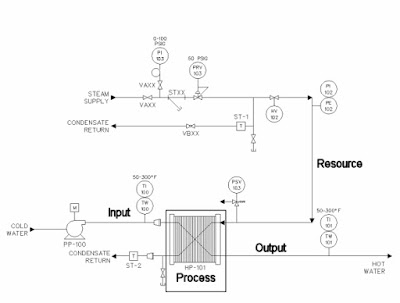Introduction
Why do we need Process Control?
Effective process control is required to maintain safe operations, quality products, and business viability.
Safety: The primary purpose of a Process Control system is safety: personnel safety, environmental safety and equipment safety. The safety of plant personnel and the community is the highest priority in any operation. An example of safety in a common heat exchanger process is the installation of a pressure relief valve in the steam supply. Other examples of safety incorporated into process control systems are rupture disks and blow out panels, a pressure switch that does not allow a pump to over pressurize a pipe or a temperature switch that does not allow the fluid flowing through a heat exchanger to overheat.
Quality: In addition to safety, process control systems are central to maintaining product quality. In blending and batching operations, control systems maintain the proper ratio of ingredients to deliver a consistent product. They tightly regulate temperatures to deliver consistent solids in cooking systems. Without this type of control, products would vary and undermine quality.
Profit: When safety and quality concerns are met, process control objectives can be focused on profit.
All processes experience variations and product quality demands that we operate within constraints. A batch system may require +- 0.5% tolerance on each ingredient addition to maintain quality. A cook system may require +- 0.5 degrees on the exit temperature to maintain quality. Profits will be maximized the closer the process is operated to these constraints. The real challenge in process control is to do so safely without compromising product quality.
Copyright Control Station
What is a Process?
A process is broadly defined as an operation that uses resources to transform inputs into outputs. It is the resource that provides the energy into the process for the transformation to occur.
Figure 1-3
Figure 1-4 shows a hot water generation process commonly found in plants. The input to this process is cold water and the output of the process is hot water. Steam is the resource that provides energy for the transformation to occur within the heat exchanger plates.
Figure 1-4
Most plants operate multiple types of processes, including separation, blending, heating, and cooling to name a few. Each process exhibits a particular dynamic (time varying) behavior that governs the transformation, that is, how do changes in the resource or inputs over time affect the transformation. This dynamic behavior is determined by the physical properties of the inputs, the resource and the process itself. A typical heat exchanger process contains a plate and frame heat exchanger to transfer the heat from the steam to the incoming water. The properties of the incoming water (temperature), the steam (pressure) and properties of the specific heat exchanger used (surface area, efficiency of heat transfer) will determine the dynamic behavior, that is; how will the output be affected by changes in water temperature or steam pressure (flow)?
What is Process Control?
Process control is the act of controlling a final control element to change the manipulated variable to maintain the process variable at a desired Set Point.
A corollary to the definition of process control is a controllable process must behave in a predictable manner. For a given change in the manipulated variable the process variable must respond in a predictable and consistent manner. Following are definitions of some terms we will be using in out discussion of process control:
- The manipulated variable (MV) is a measure of resource being fed into the process, for instance how much thermal energy.
- A final control element (FCE) is the device that changes the value of the manipulated variable.
- The controller output (CO) is the signal from the controller to the final control element.
- The process variable (PV) is a measure of the process output that changes in response to changes in the manipulated variable.
- The Set Point (SP) is the value at which we whish to maintain the process variable at.
Figure 1-5 shows a block diagram of a process with a final control element and sensors to measure the manipulated variable and process variable. In single loop control systems the actual value of the manipulated variable is often not measured, the value of the process variable is the only concern.
Figure 1-6 shows a heat exchanger. We see that the manipulated variable (MV) is steam pressure. The final control element is the valve, by changing the valve opening we are changing the flow of steam which we can measure by its pressure. The process variable (PV) is the temperature of the water exiting the heat exchanger; this is the measure of the process output that responds to changes in the flow of steam.
This is a controllable process because opening the valve will always lead to an increase in temperature, conversely closing the valve will always lead to a decrease in temperature. If this were not true, if sometimes on closing the valve we had an increase in temperature, the process would not be controllable.






No comments:
Post a Comment